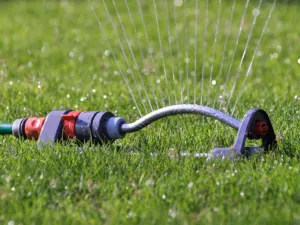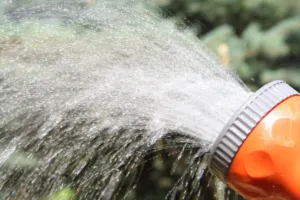
Top Drought-Resistant Grasses & Water-Saving Hacks
Learn How Southern Turf Reacts to Dry Spells
Going through a drought? These conditions can wreak havoc on your lawn. However, knowing what warm-season grass you have is important. So let’s explore the drought-resistant turf varieties and how they survive dry conditions. Plus, expert water-saving strategies to keep your lawn alive even during the most brutal heat wave.

Warm-Season Grasses in Drought Conditions
Warm-season grasses like Bermuda, Zoysia, and St. Augustine originate from tropical and subtropical regions where water scarcity is common. These grasses have developed three key survival strategies:
- Healthy root systems that efficiently extract moisture from the soil
- Dense growth patterns that reduce water evaporation
- Dormancy mechanisms that allow them to temporarily shut down during extreme drought
Understanding these natural adaptations helps homeowners in Alabama, Arkansas, Florida, Oklahoma, Tennessee, Georgia, and South Carolina make smarter choices about lawn care during dry periods. Let’s take a look at the top performers in detail.
The 5 Best Drought-Resistant Warm-Season Grasses
1. Bermuda Grass
Bermuda grass is the gold standard for drought resistance among warm-season varieties. Its secret lies in:
- An extensive root system reaching 6+ feet deep
- Rapid growth that quickly recovers from stress
- Excellent heat tolerance up to 110°F
Water Needs: Survives on just 1 inch of water every 2-3 weeks when dormant
Best For: Full sun areas with high foot traffic Does not stay green in winter so not recommended in Florida
Recovery Time: Can Green up within a week after rainfall returns
2. Zoysia Grass
Zoysia offers a balance of drought resistance and aesthetic appeal:
- Thick, carpet-like growth
- Waxy leaf coating reduces water loss
- Slow growth means less frequent mowing but does not respond quickly to fertilizer
Water Needs: Requires less water than St. Augustine
Best For: Homeowners wanting a lush look with reduced watering but understand it does not maintain color well and also turns brown in winter months in Florida
Special Feature: Naturally some lawn pests do not attack as easily as other warm season grasses but is susceptible to diseases
3. St. Augustine Grass
While not as drought-hardy as Bermuda or Zoysia, St. Augustine has advantages:
- Best warm-season grass for winter months. Maintains green color
- Wide blades retain moisture effectively
- Spreads quickly to fill in bare spots
Water Needs: 1.5-2 inches weekly during summer (more than other warm-season grasses)
Best For: Florida regions and partially shaded lawns and maintaining green color in winter months
4. Centipede Grass
Dubbed the “lazy man’s grass,” Centipede offers:
- Moderate drought tolerance
- Very low fertilizer requirements
- Slow growth means less mowing
Water Needs: Can survive 3-4 weeks without water
Best For: Acidic soils in the Southeast
5. Bahia Grass
Common in highway medians for good reason:
- Deep roots access subsoil moisture
- Grows well in poor, sandy soils
- Naturally thin and will not thicken up even with fertilization treatments
Water Needs: Can survive with just 1 inch of water monthly
Best For: Large, low-maintenance properties. Not recommended for home lawns
Recognizing Drought Stress in Warm-Season Grasses
Even drought-resistant grasses show warning signs when water becomes scarce. Look for these indicators:
- Color Changes: Transition from vibrant green to dull blue-gray, then straw brown
- Footprint Test: Grass stays flattened after walking on it
- Leaf Curling: Blades fold lengthwise to conserve moisture
- Slow Recovery: Takes longer to bounce back after mowing
- Soil Cracks: Visible gaps forming in the soil surface
Catching these signs early allows you to contact the professionals at Fairway Lawns before permanent damage occurs.

Watering Strategies for Drought Conditions
1. The Deep Watering Method
- Water 1-1.5 inches in a single session
- Promotes roots to grow deeper
- Frequency: Every 7 days for most warm-season grasses minimum. Ideal 2 times a week 1 inch each session during summer high heat months. Adjust schedule when receiving rainfall
2. Optimal Watering Times
- Best: 4-8 a.m. (reduces evaporation by 30%)
- Avoid: Evening watering (promotes fungal growth)
3. Dormancy Management
For Bermuda and Zoysia:
- Can go fully dormant (brown) during extreme drought
- Provide 0.5″ water every week to keep roots alive
- Will green up within 1-2 weeks when rains return
4. Irrigation Efficiency Tips
- Use a tuna can to measure water output to set timer correctly on irrigation
- Install a smart controller with weather adjustment
- Consider drip irrigation for sloped areas
More Drought-Proofing Essentials
- Mowing High: Keep grass at 3-4 inches to shade roots
- Aerate Annually: Improves water penetration by 50%
- Topdress with Compost: Adds organic matter to retain moisture
Recovering Your Lawn After Drought
When normal rainfall returns:
- Gradually decrease watering over 2 weeks
- Apply a balanced, slow-release fertilizer
- Monitor for pest outbreaks (common after drought stress)
- Continue deep, infrequent watering to maintain drought tolerance
Is Your Grass Showing Signs of Drought Stress?
Don’t wait until it’s too late! Call the lawn care experts at Fairway Lawns. We proudly serve seven states and dozens of communities, ensuring high-quality lawn care and pest control services across the South:
- Huntsville, AL
- Birmingham, AL
- Bentonville, AR
- Bella Vista, AR
- Searcy, AR
- Jacksonville, AR
- Greenbriar, AR
- Beebe, AR
- Cabot, AR
- Rogers, AR
- Fayetteville, AR
- Conway, AR
- Springdale, AR
- Fort Smith, AR
- Little Rock, AR
- Jacksonville, FL
- Augusta, GA
- Tulsa, OK
- Columbia, SC
- Greenville, SC
- Charleston, SC
- Knoxville, TN
- Nashville, TN
- Memphis, TN